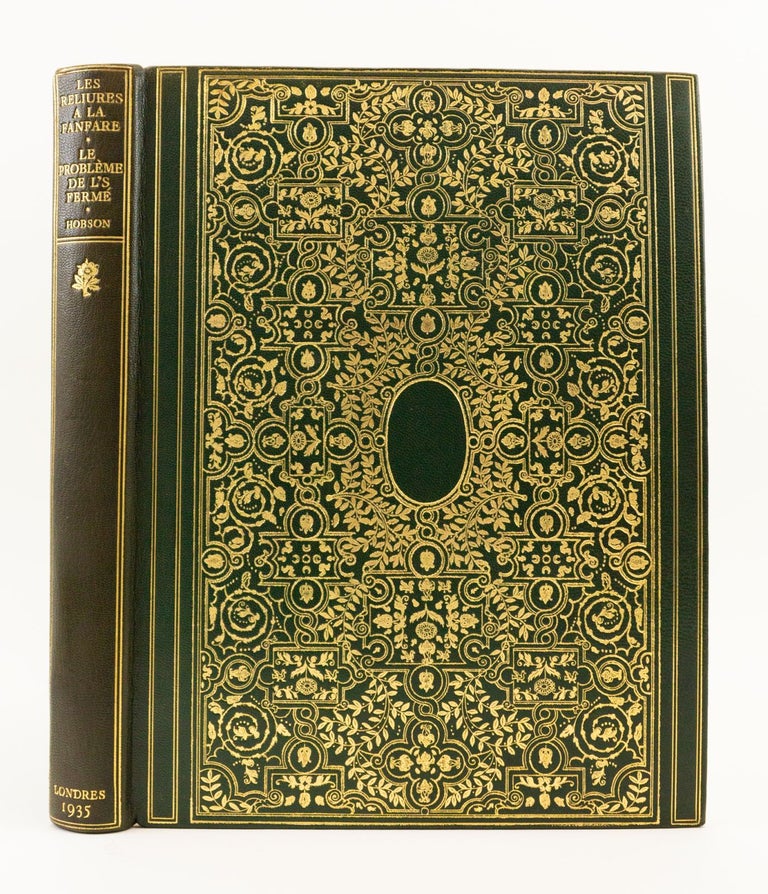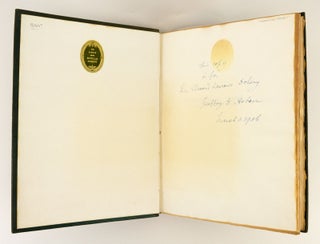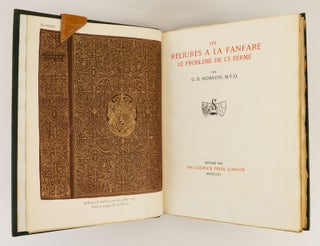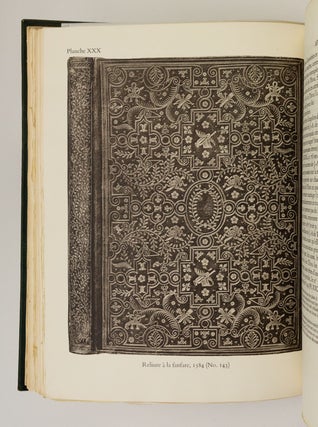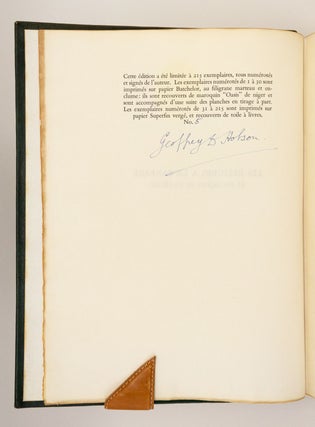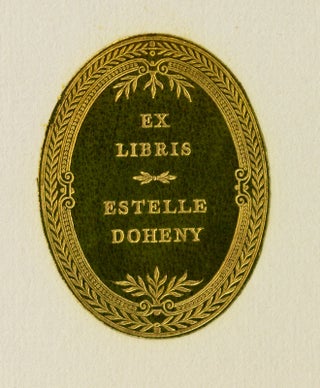LES RELIURES À LA FANFARE: LE PROBLÈME DE L'S FERMÉ.
(London: Chiswick Press for the Société des Bibliophiles Français, 1935). 332 x 245 mm. (12 3/4 x 9 1/2"). 6 p.l., 151, [3] pp. With bifolium of additions and corrections laid in at rear. No. 5 OF 30 printed on Batchelor paper, SIGNED by the author, from a total edition of 215 copies.
Imposing dark green crushed morocco by Leighton-Straker (stamp-signed on rear turn-in), covers exuberantly gilt à la fanfare, the design inspired by the 16th century bindings described in the book, smooth spine ruled in gilt, with gilt titling and small floral ornaments, top edge gilt, other edges untrimmed. With numerous figures in the text, 37 plates (29 black & white, three of these folding; eight in color), all with tissue guards. Front pastedown with morocco bookplate of Estelle Doheny; front free endpaper INSCRIBED BY HOBSON TO ESTELLE DOHENY, dated March 3, 1936; the 13 June 1936 (rave) review of the book clipped from the [London] Times Literary Supplement laid in at front. Doheny sale, Christie's New York, Feb 1, 1988, lot 384 (this copy); Bonino, "The Doheny Mansion: A Biography of a Home" (2008). ◆Spine evenly sunned to olive green, light offsetting from color plates, other very trivial imperfections, but A VERY FINE COPY, with virtually no signs of use inside or out.
This specially bound copy of the definitive reference book on fanfare bindings, by the leading authority on bookbindings of his day, was inscribed by the author to one of the most important collectors of fine bindings of the 20th century. The main features of the fanfare style, in Glaister's words, "are interlacing ribbons" that form "compartments of various shapes, with emphasis given to a central compartment. This interlacing ribbon is bounded by a double line on one side and a single one on the other." Ornaments made with small hand tools "fill all the compartments except the central one and almost completely cover the sides."
Geoffrey Dudley Hobson (1882-1949) got a first-class degree from Oxford University, but severe hearing loss kept him from pursuing his intended profession in the law. He became part of the group that purchased the Sotheby's auction house in 1908, and he contributed much to the business administration and scholarly research of that firm. According to DNB, the respect Hobson had earned as a longtime bibliophile "made Sotheby's the centre of the world's rare book business, and the scholarly standards he attempted to impose across all areas of the business improved the standing of the firm significantly." The present work contains what Bernard Breslauer called "one of Hobson's most ingenious investigations," into the fanfare style of 16th century French bookbindings and the binders who created them, addressing in particular the origin of the "closed S" tool (one in which the serifs at either end of the letter close the openings created by its curves).
Hobson inscribed this copy to Estelle Doheny (1875-1958), one of the most distinguished women book collectors of the 20th century, whose magnificent library was especially rich in fine bindings. The wife of oil tycoon Edward Doheny, Estelle began collecting books in the 1920s, eventually amassing a library of approximately 7,000 books and 1,300 manuscripts. Her interests included illuminated manuscripts, incunabula, and Western Americana in addition to fine and historic bindings, and her collection of fore-edge paintings was the most extensive ever assembled. In the summer of 1931, at the height of the Depression, she spent an average of $1,000 per day on books, according to Bonino; certainly, she would have been an important patron to Hobson and others in the rare book world. (ST16662)
Price: $4,500.00

